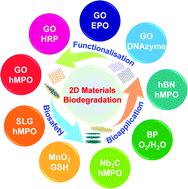当前位置:
X-MOL 学术
›
Chem. Soc. Rev.
›
论文详情
Our official English website, www.x-mol.net, welcomes your
feedback! (Note: you will need to create a separate account there.)
Degradation-by-design: how chemical functionalization enhances the biodegradability and safety of 2D materials.
Chemical Society Reviews ( IF 40.4 ) Pub Date : 2020-07-29 , DOI: 10.1039/c9cs00822e Baojin Ma 1 , Cristina Martín , Rajendra Kurapati , Alberto Bianco
Chemical Society Reviews ( IF 40.4 ) Pub Date : 2020-07-29 , DOI: 10.1039/c9cs00822e Baojin Ma 1 , Cristina Martín , Rajendra Kurapati , Alberto Bianco
Affiliation

|
A large number of graphene and other 2D materials are currently used for the development of new technologies, increasingly entering different industrial sectors. Interrogating the impact of such 2D materials on health and environment is crucial for both modulating their potential toxicity in living organisms and eliminating them from the environment. In this context, understanding if 2D materials are bio-persistent is mandatory. In this review we describe the importance of biodegradability and decomposition of 2D materials. We initially cover the biodegradation of graphene family materials, followed by other emerging classes of 2D materials including transition metal dichalcogenides and oxides, Xenes, Mxenes and other non-metallic 2D materials. We explain the role of defects and functional groups, introduced onto the surface of the materials during their preparation, and the consequences of chemical functionalization on biodegradability. In strong relation to the chemistry on 2D materials, we describe the concept of “degradation-by-design” that we contributed to develop, and which concerns the covalent modification with appropriate molecules to enhance the biodegradability of 2D materials. Finally, we cover the importance of designing new biodegradable 2D conjugates and devices for biomedical applications as drug delivery carriers, in bioelectronics, and tissue engineering. We would like to highlight that the biodegradation of 2D materials mainly depends on the type of material, the chemical functionalization, the aqueous dispersibility and the redox potentials of the different oxidative environments. Biodegradation is one of the necessary conditions for the safe application of 2D materials. Therefore, we hope that this review will help to better understand their biodegradation processes, and will stimulate the chemists to explore new chemical strategies to design safer products, composites and devices containing 2D materials.
中文翻译:

设计降解:化学功能化如何增强2D材料的生物降解性和安全性。
当前,大量的石墨烯和其他2D材料被用于开发新技术,越来越多地进入不同的工业领域。询问此类2D材料对健康和环境的影响,对于调节其对活生物体的潜在毒性以及将其从环境中消除至关重要。在这种情况下,必须了解2D材料是否具有生物持久性。在这篇综述中,我们描述了生物可降解性和2D材料分解的重要性。我们首先介绍了石墨烯族材料的生物降解,然后介绍了其他新兴的2D材料类别,包括过渡金属二卤化物和氧化物,Xenes,Mxenes和其他非金属2D材料。我们解释了缺陷和功能组的作用,在制备过程中引入到材料表面,以及化学功能化对生物降解性的影响。与2D材料的化学性质密切相关,我们描述了我们致力于发展的“按设计降解”的概念,该概念涉及用适当的分子进行共价修饰以增强2D材料的生物降解性。最后,我们涵盖了为生物医学应用设计新的可生物降解2D共轭物和设备的重要性,这些设备可作为生物电子和组织工程中的药物输送载体。我们要强调的是,二维材料的生物降解主要取决于材料的类型,化学功能化,水分散性和不同氧化环境的氧化还原电势。生物降解是2D材料安全应用的必要条件之一。因此,我们希望这次审查将有助于更好地了解他们的生物降解过程,并将激发化学家探索新的化学策略,以设计更安全的产品,复合材料和包含2D材料的设备。
更新日期:2020-09-01
中文翻译:

设计降解:化学功能化如何增强2D材料的生物降解性和安全性。
当前,大量的石墨烯和其他2D材料被用于开发新技术,越来越多地进入不同的工业领域。询问此类2D材料对健康和环境的影响,对于调节其对活生物体的潜在毒性以及将其从环境中消除至关重要。在这种情况下,必须了解2D材料是否具有生物持久性。在这篇综述中,我们描述了生物可降解性和2D材料分解的重要性。我们首先介绍了石墨烯族材料的生物降解,然后介绍了其他新兴的2D材料类别,包括过渡金属二卤化物和氧化物,Xenes,Mxenes和其他非金属2D材料。我们解释了缺陷和功能组的作用,在制备过程中引入到材料表面,以及化学功能化对生物降解性的影响。与2D材料的化学性质密切相关,我们描述了我们致力于发展的“按设计降解”的概念,该概念涉及用适当的分子进行共价修饰以增强2D材料的生物降解性。最后,我们涵盖了为生物医学应用设计新的可生物降解2D共轭物和设备的重要性,这些设备可作为生物电子和组织工程中的药物输送载体。我们要强调的是,二维材料的生物降解主要取决于材料的类型,化学功能化,水分散性和不同氧化环境的氧化还原电势。生物降解是2D材料安全应用的必要条件之一。因此,我们希望这次审查将有助于更好地了解他们的生物降解过程,并将激发化学家探索新的化学策略,以设计更安全的产品,复合材料和包含2D材料的设备。











































 京公网安备 11010802027423号
京公网安备 11010802027423号